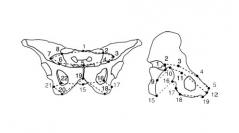

 Comptes Rendus Palevol
3 (4) - Pages 295-304
Comptes Rendus Palevol
3 (4) - Pages 295-304The pelvic cavity of Australopithecus (A. afarensis, A. africanus) was compared to that of 25 Pan (P. troglodytes, P. paniscus) and 45 Homo sapiens with the use of tridimensional Procustes analysis. The fossil morphology is closer to that of modern humans than that of chimpanzees. The australopithecine birth was ante-ischiatic as in humans, indicating that the obstetrical mechanism specific to hominids has an ancient origin. As compared with modern humans, the fossils are closer to that of the female humans. However, they present noticeable differences with modern female pelves indicating that the australopithecine fetus realized a less accentuated movement of flexion and rotation, following a less curved trajectory. .
Obstetrics, Pelvis, Homo sapiens, Pan troglodytes, P. paniscus, Australopithecus africanus, A. afarensis, Procustes analysis